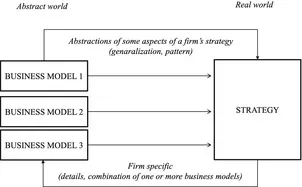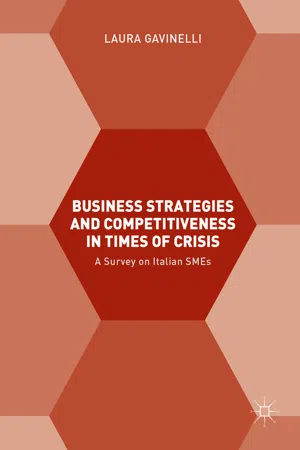Competitive advantage is the result of a strategy that leads the firm to occupy and maintain a favorable position in the market in which it operates and that is superior to that of competitors (Caroli 2009).
The ability to implement strategic decisions is strongly linked to constant analysis of internal strengths and weaknesses, together with knowledge and interpretation of the dynamics of the external environment and the development of strategic intent—that is, maintaining a common vision about the future of the enterprise, which gives direction to its development (Hamel and Prahalad 1994).
1.1 What Is Strategy?
Strategy deals with success. A person who is able, with limited resources, to recognize opportunities when they arise and to have a clear view of the path to follow, as well as the flexibility to take advantage of these opportunities, is considered successful (Grant 2005b).
The ability to implement strategic decisions is therefore strongly linked to a constant analysis of internal strengths and weaknesses, together with knowledge of and the ability to interpret the dynamics of the external environment.
The first two sections of this chapter clarify what a strategy is in terms of definition, types of strategies and the roles they play in the decision-making processes of an enterprise, and how strategic analysis for business decisions has evolved in the theoretical debate.
Strategy in entrepreneurship is strictly linked to competition, and for this reason, it entails issues like analysis of the context, offensive and defensive approaches, knowledge of rivals, defense of the gained advantage, management of resources, and so on. This leads us to the origin of the word strategy. It comes from Greek and is related to war, formed of stratos (army) and -ag (commanding). The concept of strategy was developed in Sun Tzu’s treatise The Art of War (China, 500 BC), in which instructions (strategies) were given to generals to achieve a position of advantage, as well as to carry out specific actions and the operations necessary to win (tactics).
1.1.1 What It Is: Some Definitions
Roget’s Thesaurus defines strategy as sagacity, policy, tactics, art of war, and warfare, while the Oxford Advanced Learner’s Dictionary defines it as the art of planning and directing an operation in a war or campaign, skill in planning or managing any affair well, and a plan or policy designed for a particular purpose.
The Oxford Dictionary of Marketing (2011: 256) explains marketing strategy as planned choices about which part of the market to focus on and how to compete within that target market. Strategy must be based upon a thorough analysis and the ways and means of addressing target markets and customers.
In Sun Tzu, The Art of War (2011), strategy is the main task of organizations. In situations of life and death, it is the path toward survival or extinction. Its study cannot be dismissed.
Drucker’s definition of strategic planning (1993) is closely related to the rules laid out by Sun Tzu. For Drucker, strategic planning is the continuous process of making entrepreneurial (risk-taking) decisions in the present and with the greatest knowledge of their futurity, organizing the efforts needed to carry out these decisions, and measuring the results of these decisions against the expectations through organized, systematic feedback. In other words, it is the science of making good decisions about the future. Like Sun Tzu, Drucker also sees decision-making as a process of innovation, which means knowing what to choose, and what new and different things to do in the right time.
Porter (1980, 1996, 2001) argues that strategy involves defining a firm’s long-term position in the marketplace, making difficult trade-offs about what the firm will and will not do to provide value to customers, and forging hard-to-replicate fit among parts of the systems the firm constructs to deliver value to customers, all with a view to making a superior return on investment. In this definition, operational excellence of the production system is a given consequence (Seddon and Lewis 2003: 240).
Owing to the relation between the enterprise and its competitors, Ohmae (1983) declares that everything related to business strategy is, in a word, a competitive advantage. The sole purpose of strategic planning is to enable the enterprise to achieve a sustainable advantage over its competitors as efficiently as possible.
Finally, for Grant (2005), strategy means planning in order to make organizations or individuals reach their goals. More specifically, strategy does not involve making a detailed plan or a program of instructions; rather, it is a theme that gives coherence and unity of direction to the actions and decisions of an individual or an organization. In short, a strategy is a process, a guideline that gives coherence to the decisions of an organization in order to achieve objectives.
1.1.2 What It Is Not
Strategy is not a tactic. A tactic is focused on a specific action (“battles”), while strategy is the overall plan for the “war.” Strategy is focused on deployment of the resources required to achieve a position of advantage, whether for war, business, or personal planning. Strategy and tactics are interlinked in achieving a specific objective, but they are not the same.
Business strategy is not a business model (Grant 2005b: 29). A business model is based on its capacity to generate revenue and make profit. It’s the way the business is managed and developed to make money. The focus on the internal productive factors of the enterprise is evident and includes the components and functions of the business, as well as the revenues it generates and the expenses it incurs. A business model can be simple or complex, depending on the vision and the choices made by the management of the enterprise. The critical factors are the capacity to use the characteristics of the enterprise in the most effective way in order to gain a competitive advantage, although consideration of competitors is not the priority in planning a business model. The best way to be successful is usually to adopt consolidated business models, and to adopt the most effective strategies (which means also considering the firm’s own particular competitive environment), rather than creating new models.
1.1.3 Characteristics of Strategy
Successful strategies have some common traits:
Long-term, simple, and clear goals: A medium- or long-term strategy requires goals that are clear, simple, and consistent over time. This allows the enterprise to develop a sustainable and effective plan of action, as well as to have clear and measurable checkpoints during the implementation of the plan.
A deep understanding of the competitive environment: Understanding and monitoring the environment over time is an essential prerequisite to identifying opportunities and threats to avoid, as well as market trends, the dynamics of the industry in which the enterprise operates, and the strategic behaviors of its direct and indirect competitors.
An objective assessment of the resources: The enterprise has to identify its strengths so that it can increase them and its weaknesses in order to neutralize or resize them. The resources and skills that the firm already has and those it requires in the formulation of its strategy are to be assessed.
Effective implementation of actions: Strategy gives direction to actions, ensuring their success. This means setting priorities and coordination.
Success is rarely the result of chance, or of outstanding resources or skills. It is rather the capacity to implement effective management of resources and expertise in order to respond to environmental changes quickly. The effective mix among the four elements described above—goals, environmental dynamics, resources, and actions—is the base for a good strategy.

